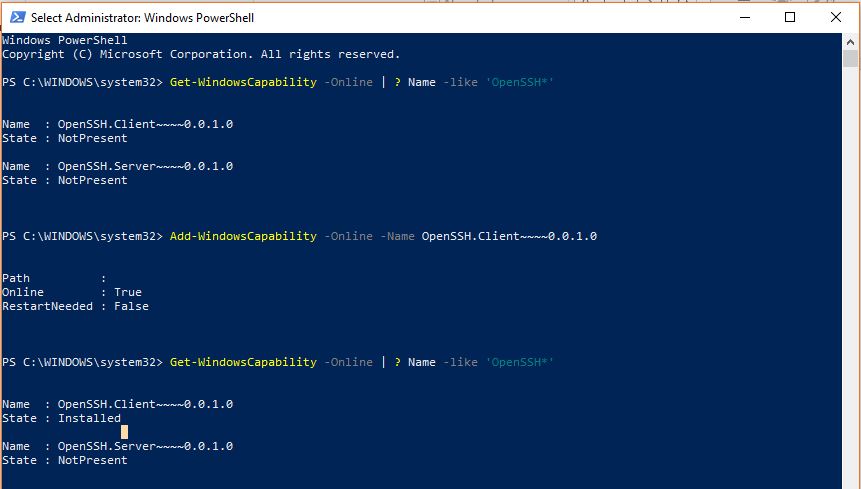

- #POWERSHELL OPENSSH INSTALL#
- #POWERSHELL OPENSSH UPDATE#
- #POWERSHELL OPENSSH WINDOWS 10#
- #POWERSHELL OPENSSH MAC#
- #POWERSHELL OPENSSH WINDOWS#
Now, click Inbound Rules in the open Firewall window.
#POWERSHELL OPENSSH WINDOWS#
In the Server Manager window, navigate to Tools, and select Windows Defender Firewall with Advanced Security from the drop-down list. Open the Windows start menu, locate and click Server Manager. start-process notepad C:\Programdata\ssh\sshd_config To configure OpenSSH, use the following command to open the main configuration file in Notepad and make your preferred changes.
#POWERSHELL OPENSSH INSTALL#
Install OpenSSH Client: Add-WindowsCapability -Online -Name OpenSSH.Client Paste the following commands to Install OpenSSH Server: Add-WindowsCapability -Online -Name OpenSSH.Server Once installed, both OpenSSH Client and Server will be available on the list of Installed Features. Next, select OpenSSH Server from the list of results, then click Install. In the new Window, navigate to Apps, and Select Optional Features under Apps & Features.Ĭlick Add Feature, then enter the keyword OpenSSH in the search box. Deploy a Windows Server 2019 or 2022 Server at Vultr.In this guide, you’ll install OpenSSH on a Windows Server.

As a result, it eliminates connection hijacking, sniffing, eavesdropping, among other common network attacks.

#POWERSHELL OPENSSH WINDOWS 10#
All rights C:\Users\demo>Īnd that’s it, you can now install OpenSSH server on your Windows 10 system.OpenSSH is a secure remote access tool that encrypts traffic between the connecting client and a remote server. Warning: Permanently added '192.168.0.111' (ECDSA) to the list of known password:
#POWERSHELL OPENSSH MAC#
So let’s test it out, I’m going to ssh from my Mac into my Windows 10 laptop My-MacBook-Pro:~ aen$ ssh authenticity of host '192.168.0.111 (192.168.0.111)' can't be established.ĮCDSA key fingerprint is SHA256:eQti/VKAXhTgbLGTqD3n/QOxcPvfdIT6rwuIK+8F5Vs.Īre you sure you want to continue connecting (yes/no)? yes You’ll likely need to open your Windows firewall, which can be done with the following cmdlet on PowerShell 5.1 New-NetFirewallRule -Name sshd -DisplayName 'OpenSSH Server (sshd)' -Enabled True -Direction Inbound -Protocol TCP -Action Allow -LocalPort 22 So now that it’s up and running, you should know that the configuration files and host keys live in ProgramData\ssh\ so if you need to change the behavior of SSH you’ll head for the sshd_config file and when finished, restart your service with Restart-Service -Name sshd PS C:\Users\aen> Get-ChildItem -Path 'C:\ProgramData\ssh\' Proto Local Address Foreign Address State PID We can use netstat to see if we’re up and running PS C:\WINDOWS\system32> netstat -bano | more PS C:\WINDOWS\system32> Get-Service -Name *ssh* | Start-Service Stopped ssh-agent OpenSSH Authentication AgentĪs you can see the state is stopped, so let’s start the Services and also set them to start on boot PS C:\WINDOWS\system32> Get-Service -Name *ssh* | Set-Service -StartupType Automatic We can see with the Get-Service cmdlet, the installer added ssd and also ssh-agent! PS C:\Users\aen> Get-Service -Name *ssh* On Windows systems, network daemons run as “Services”. With that installed, let’s take a look at where sshd lives on our Windows system and that’s in C:\Windows\System32\OpenSSH\ PS C:\> Get-ChildItem C:\Windows\System32\OpenSSH\

To confirm it’s installation we can use the Get-WindowsCapability cmdlet again, and this time it’s state is “Installed” PS C:\WINDOWS\system32> Get-WindowsCapability -Online | Where-Object -Property Name -Like "OpenSSH.Server*" Now to install OpenSSH server, we can use the Add-WindowsCapability cmdlet PS C:\WINDOWS\system32> Add-WindowsCapability -Online -Name OpenSSH.Server~~~~0.0.1.0 PS C:\> Get-WindowsCapability -Online | Where-Object -Property Name -Like "OpenSSH*" With that installed, let’s check out the new Windows Capabilities (Features) available in this Update, we can use PowerShell to search through them.
#POWERSHELL OPENSSH UPDATE#
Do that using your normal update mechanisms. So in yesterday’s post we learned that the OpenSSH client is included with the Windows 10, Update 1803! Guess, what else is included in this server, an OpenSSH Server! Yes, that’s right…you can now run an OpenSSH server on your Windows 10 system and get a remote terminal! So in this post, let’s check out what we need to do to get OpenSSH Server up and running.įirst, we’ll need to ensure we update the system to Windows 10, Update 1803.


 0 kommentar(er)
0 kommentar(er)
